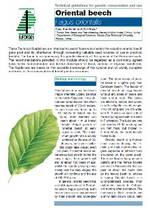Fagus orientalis - Technical guidelines for genetic conservation and use for oriental beech
Conservation of oriental beech genetic resources is carried out mainly by setting up seed stands and gene conservation forests as part of in situ programmes. Seed collected from these areas can be used for reforestation following the seed transfer zones. Furthermore, there are other conservation programmes such as national parks and nature conservation areas which harbour oriental beech stands that can be used as seed sources. There is no information concerning ex situ conservation of oriental beech genetic resources. In reforestation programmes the minimum requirement should be that the origin of the reproductive material is known and its adaptive characters should be appropriate for the ecological conditions at the regeneration site. For this purpose, the “Guidelines for oriental beech seed transfer zones”, (Atalay, 1992) based on climate, soil and bedrock characteristics could be used until new seed transfer guidelines are prepared. These guidelines were prepared for the natural range of oriental beech in Turkey, but could be used as a reference by neighbouring countries.
A system for the control of reproductive material should be applied and recommendations for proper use of different reproductive material should be developed. The Council Directive 1999/105/EC on the marketing of forest reproductive material provides basic definitions of current categories of reproductive material. In years with abundant seed of oriental beech, seed lots should be harvested and stored in sufficient amounts, even though it is expensive and difficult to maintain the viability of seeds in storage.
Seed stands alone may not fulfil the actual requirements for the conservation of genetic resources of oriental beech, especially those populations located in extreme habitats and refuge areas. Therefore, there may be a need for gene conservation forests to be set up from natural stands and managed according to proper silvicultural plans, to ensure the potential for successful natural regeneration. The objective is to maintain the potential for continuous future evolution of the population. It has been suggested that gene conservation forests should cover certain minimum areas in order to maintain sufficient amounts of genetic variability. An approximate estimate would be 100 ha including core and buffer zones. However, the area could be smaller to conserve locally adapted populations. Such forests may also contain other tree species if they are admixed with oriental beech.
The establishment of ex situ conservation plantations of oriental beech may be necessary in order to conserve the genetic variation of threatened populations that cannot be maintained at the original site, such as relic populations. The objective will be to establish a new population that maintains as much as possible of the original genetic variability and allows long-term adaptation to the local conditions at the planting site. It can be established by planting seedlings, but also by direct sowing. Stands of 10 ha are generally recommended for this purpose.
Authors: Gaye Eren Kandemir; Zeki Kaya
Journal/Series: EUFORGEN Technical Guidelines for Genetic Conservation and Use
Publication Year: 2009
Publication Format: PDF
ISBN 13: 978-92-9043-804-5
Language: EN
Pages: 6 p.

